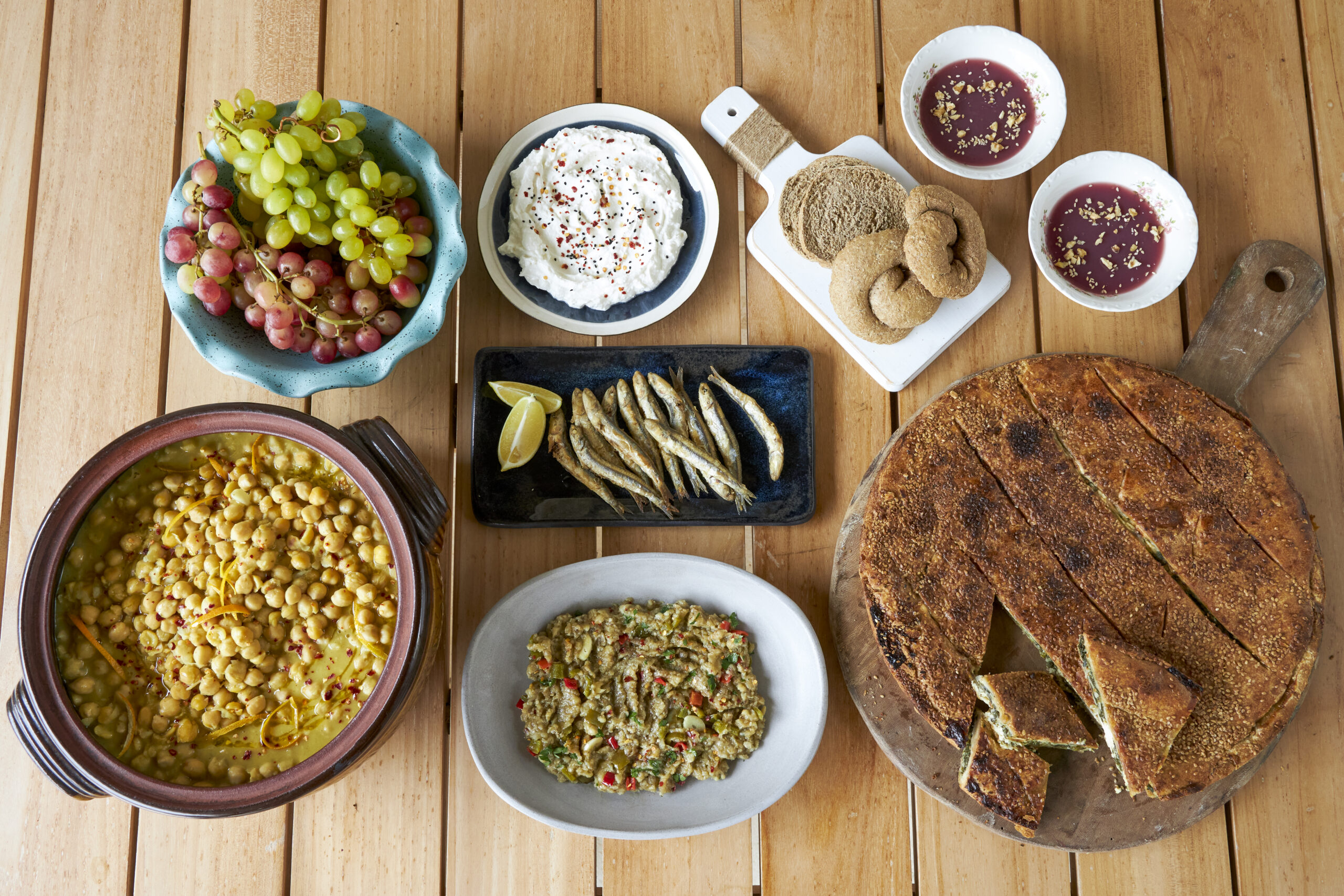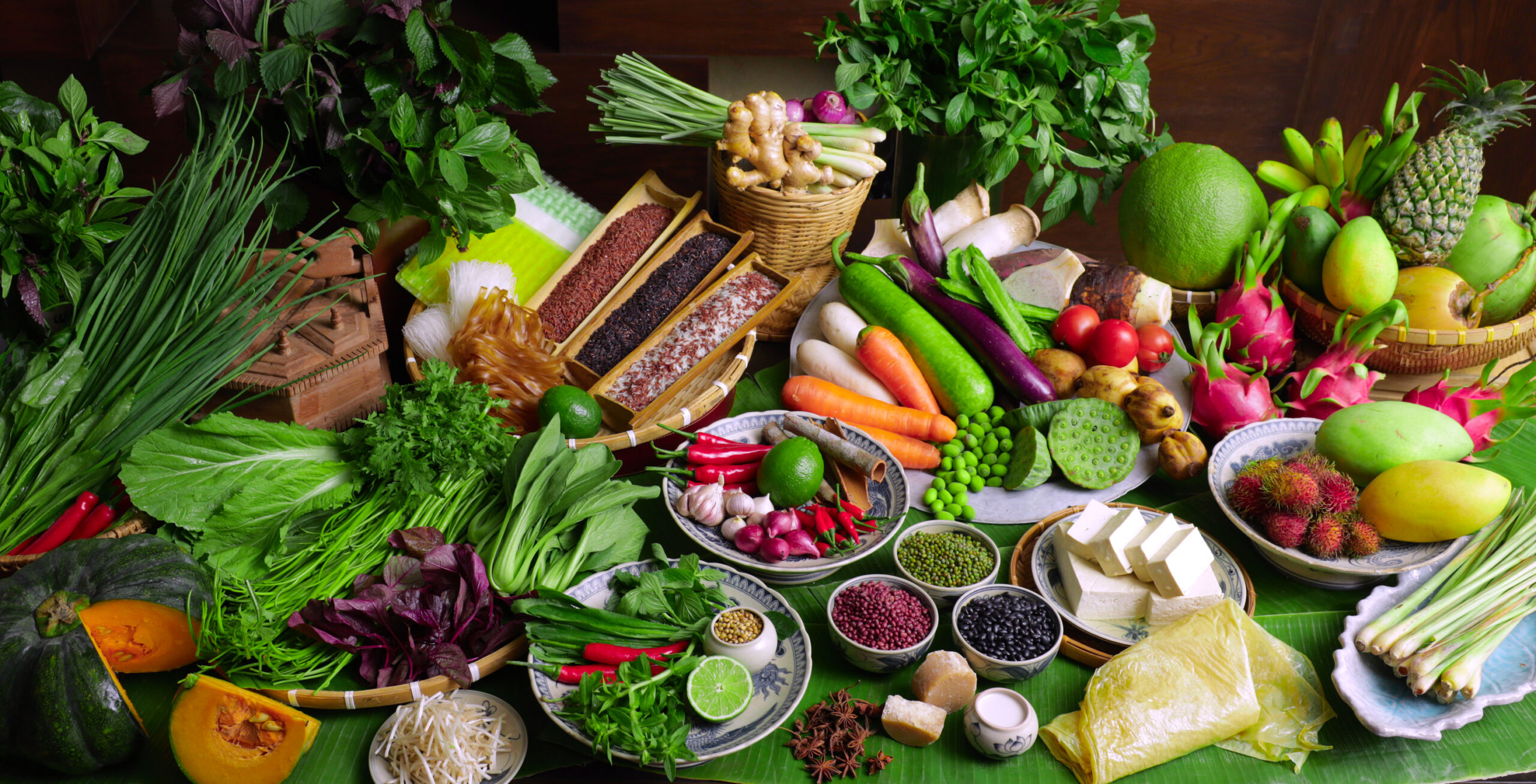Greece and the
Plant-Forward
Kitchen
The traditional, weekly meal patterns of Greeks reflect what we now understand to be the framework of the healthy Mediterranean Diet.
The roots of the traditional, plant-rich Greek dietary pattern stretch back millennia.
Historically, the market basket of Greece has been shaped by the country’s warm, semi-arid climate; its proximity to the Mediterranean Sea; and the endless groves of olive trees that blanket many parts of the country and form the basis of the cuisine.
The evolution of the country’s cuisine—its ingredients and flavors, culinary techniques and recipe concepts—is a story of centuries of exchange, by sea and by land. From contact and trade with the Egyptians and Phoenicians to impacts from the Roman, Byzantine and Ottoman empires to rule by the Venetians and much more, Greece and its food are part of the cultural fabric of the greater Mediterranean region. And yet, the country and its dietary heritage also have a unique identity with strong relevance to today’s food, nutrition and planetary health imperatives.
The traditional, weekly meal patterns of Greeks reflect what we now understand to be the framework of the healthy Mediterranean Diet. These patterns further align well with the Planetary Health Diet (PHD) recommended by the 2025 EAT-Lancet Commission Report. Rich in fruits and vegetables, grains (often whole), legumes, nuts and olive oil, the Greek diet has also traditionally included dairy foods—principally yogurt and various cheeses—fish and seafood, and small amounts of poultry and meat. On special occasions, larger portions of lamb or other meats might be prepared.
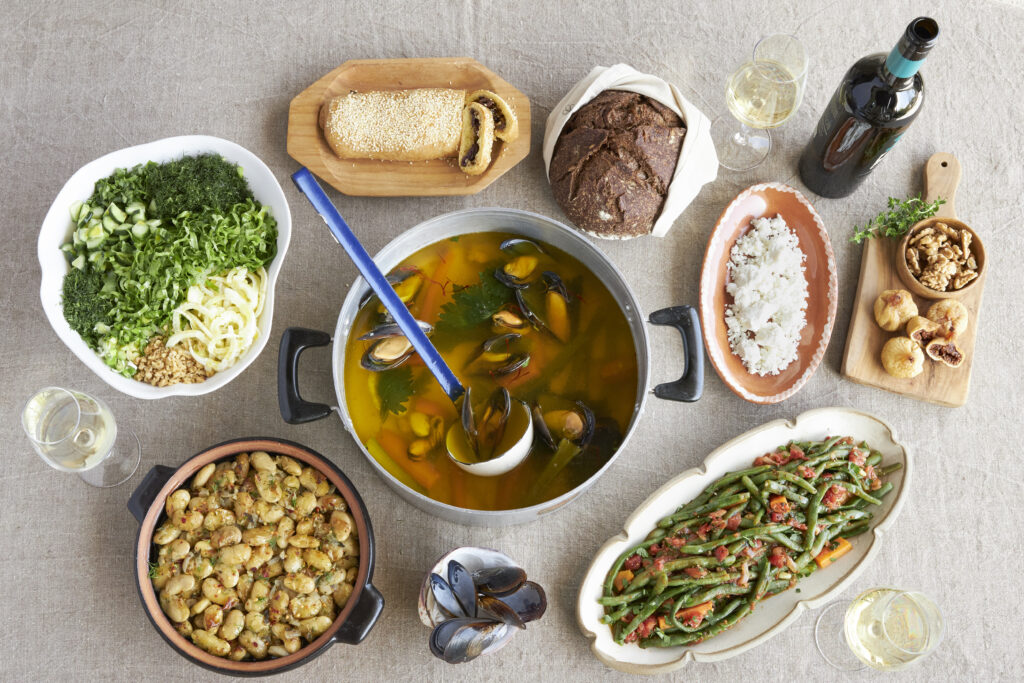
In the early 1960’s, on the Greek island of Crete as recorded by the Seven Countries Study, red meat and poultry accounted for a very small part of the diet: just under 9 ounces (or about 245 grams) per week. The mountainous geography of much of Greece inhibited the larger-scale agriculture (including large-scale grain production) common in the north of Europe. This, in turn, prevented cattle from becoming central to Greek agriculture as it had elsewhere in the world. Goats and sheep—smaller, more agile and adaptable to challenging, often semi-arid food environments—were far better suited to the hilly landscapes. These animals—in smaller numbers—yielded less meat than large herds of cattle, and thereby substantially impacted the evolution of Greece’s traditional dietary pattern.
The country’s Greek Orthodox religion has also long played a substantial role in shaping the traditional Greek diet. Many Greeks still observe some portion of the traditional 40 days of Lent three times a year, plus every Wednesday and Friday, which can add up to a total of 180-200 fasting days per year with varying restrictions against eating most animal products on those days, including red meat, poultry and dairy. These centuries-old Lenten traditions created a heritage of plant-rich, vegetarian and vegan dishes which still constitute some of the most beloved of all foods for Greeks.
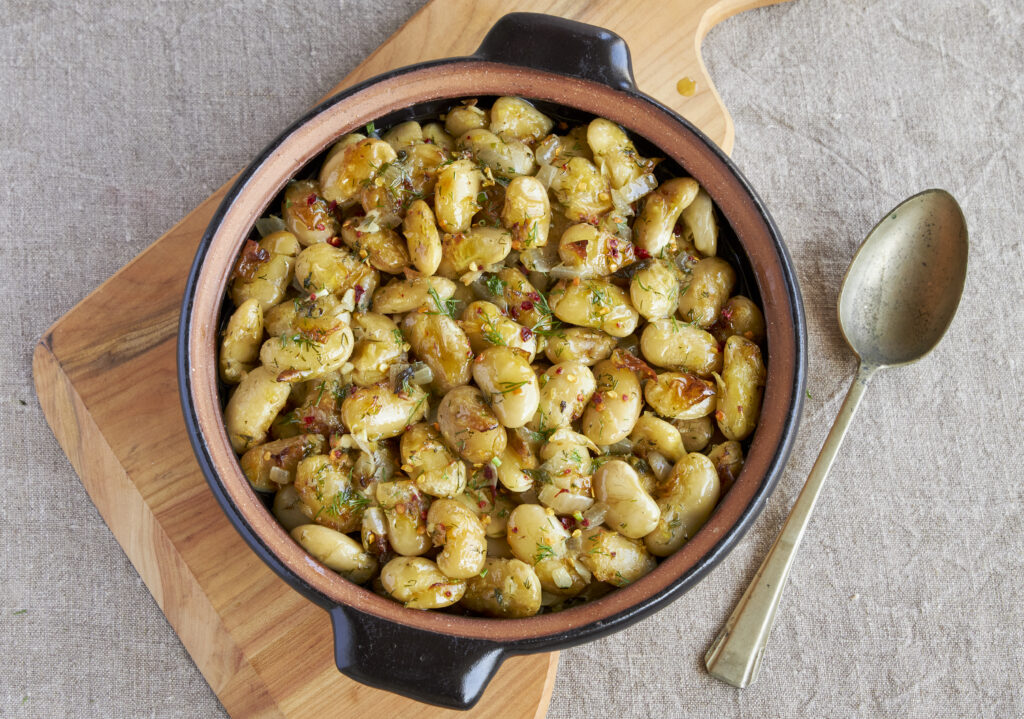
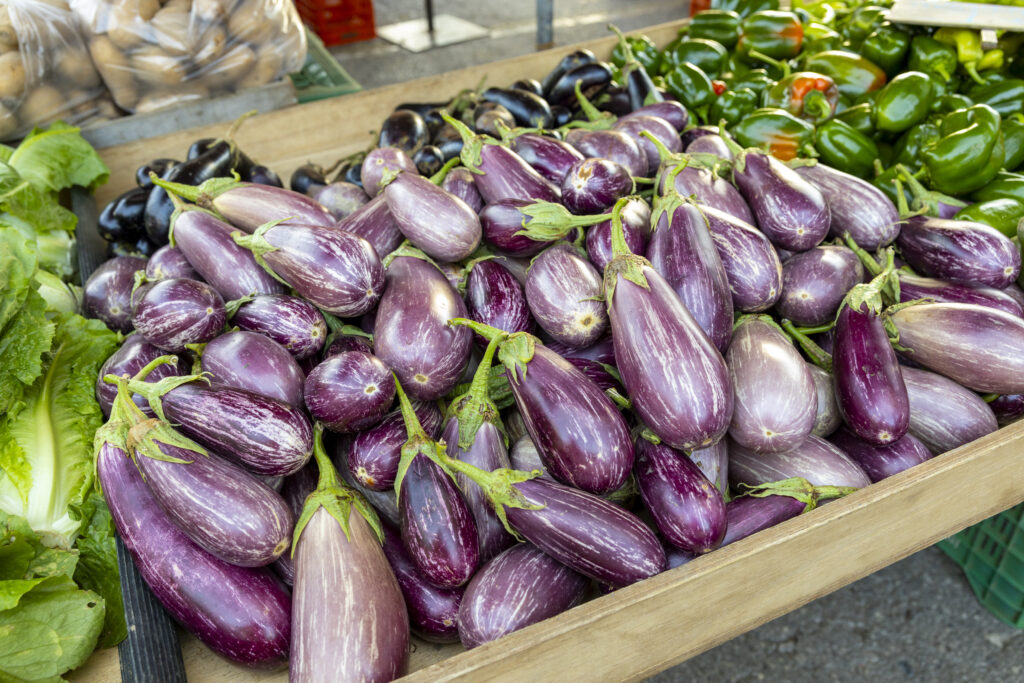
Plant proteins—including in the form of fava beans, yellow split peas, lentils, chickpeas and dried beans as well as a variety of nuts such as walnuts, almonds, pine nuts and pistachios—play a prominent role at the Greek table. Delicious, locally produced fresh and dried fruit often edges out sweets for dessert. And the sheer abundance of fresh vegetables in the Greek kitchen—including a great diversity of greens and herbs, often wild and gathered in the mountains—also merit special attention.
In the early 1960’s, when Greece was most closely identified with the articulation of the traditional, healthy Mediterranean diet model, fruit and vegetable consumption in Greece was among the highest of all countries in Europe and the Mediterranean.
Finally, olive oil, including micronutrient-rich extra-virgin olive oil, represented a substantial portion of the calories in the traditional, healthy Greek diet, and was (and is) ever present both in the kitchen and at the table, along with bread and moderate amounts of wine. It is impossible to overstate the role that olive cultivation has had on the evolution of Greek food culture and its dietary traditions. It’s not uncommon to find olive groves in the country that date back centuries, with some olive trees in the two largest olive producing regions—Messinia in the Peloponnese and Crete—thought to have trees as old as 1,000 years and 2,000-4,000 years, respectively.
Throughout its history, the olive has had special significance and is associated with the goddess Athena. Its oil was used in lamps to light houses, served important medicinal and religious functions, was valued for its role in beauty and athletic performance, and was an important driver of trade. Similarly, in cooking and baking in the traditional Greek kitchen, olive oil was not simply what was used when sautéing or frying or dressing salads—its flavors and functions fully shaped and defined the cuisine.
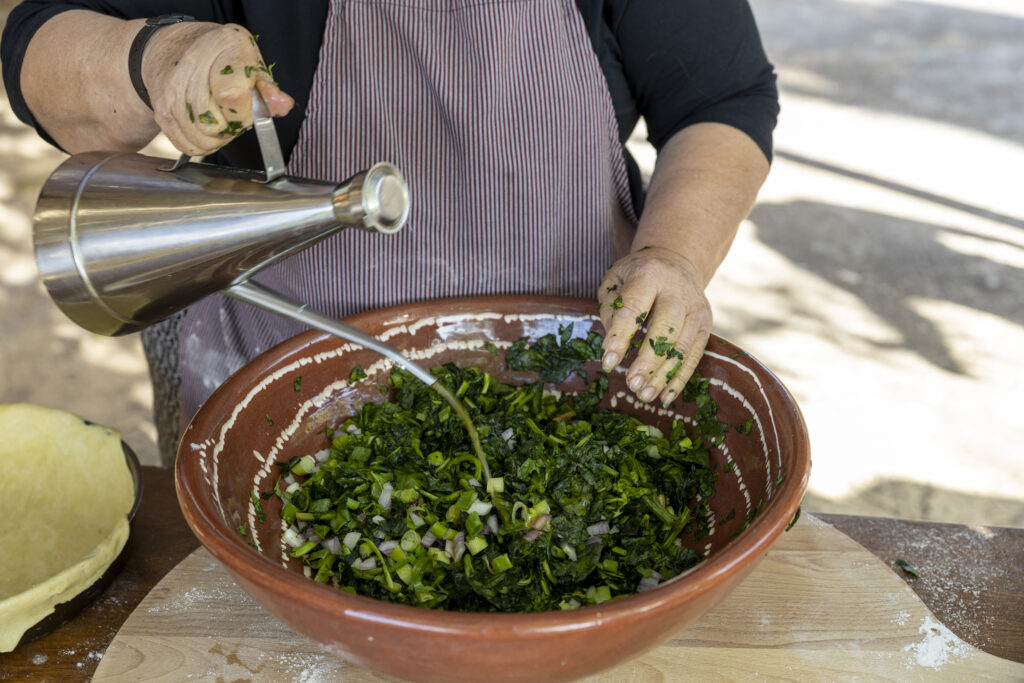
I’ve had to explain over the years that we don’t love vegetables any more than they do. We love our vegetable dishes because of how we prepare them, with olive oil, with other indigenous ingredients, and with the techniques we learned from our mothers and grandmothers.
Turning to the current period, though more animal-based foods and highly processed foods have displaced some of the healthier food choices in the Greek diet, it is still easy to find these foods and flavors—and elements of these traditional, plant-rich meal patterns—in Greek home cooking and on the country’s restaurant menus.
This collection of images demonstrates how the traditional Greek Mediterranean Diet—and the 2025 EAT-Lancet Planetary Healthy Diet that it illustrates—can serve up wonderful diversity across many meals. The cooking and photography for this Greek edition took place in the region of Messinia (on Greece’s Peloponnese peninsula).
All of the menus for the main, featured meals that follow are designed for a gathering of six (6) friends and family members. In some cases, oven-baked items or dishes that are a bit more complicated to make might show up in larger portions on these dinner tables but are intended to be part of more than one meal.
th
Greek Family Meal 1
A layer of hand-rolled phyllo wraps up wild greens, herbs and feta in this savory pie known as hortopita. This baked chickpea stew, revithia sto fourno, seasoned with orange peel is slowly cooked for many hours in an earthenware pot in a low-heat oven. Greek cooks often make more than enough servings of both hortopita (because it’s labor intensive) and chickpeas (because they take a long time) with the expectation of having leftovers in the days ahead. Eggplants roasted over a fire and then mashed, melitzanosalata transforms into a salad or mezze, variations of which are found throughout the Eastern Mediterranean. Anchovies, gavros, like other small fish in Greece, are marinated, fried or roasted whole and served with lemons. There’s only enough here for a small serving of fish—reflecting the one to two servings a week recommended by the 2025 EAT-Lancet Commission. Yogurt, strained until it’s thickened and cheese-like, straggisto, topped with nigella seeds and red pepper flakes, provides a small amount of dairy in the meal. Dakos, hard biscuit-like bread made with whole-grain barley flour are baked twice to dry out. For a sweet finish moustalevria, a grape pudding made from fresh pressed, unfermented grape juice, is served. It is thickened with cornstarch, lightly sweetened with honey and topped with a few chopped nuts.
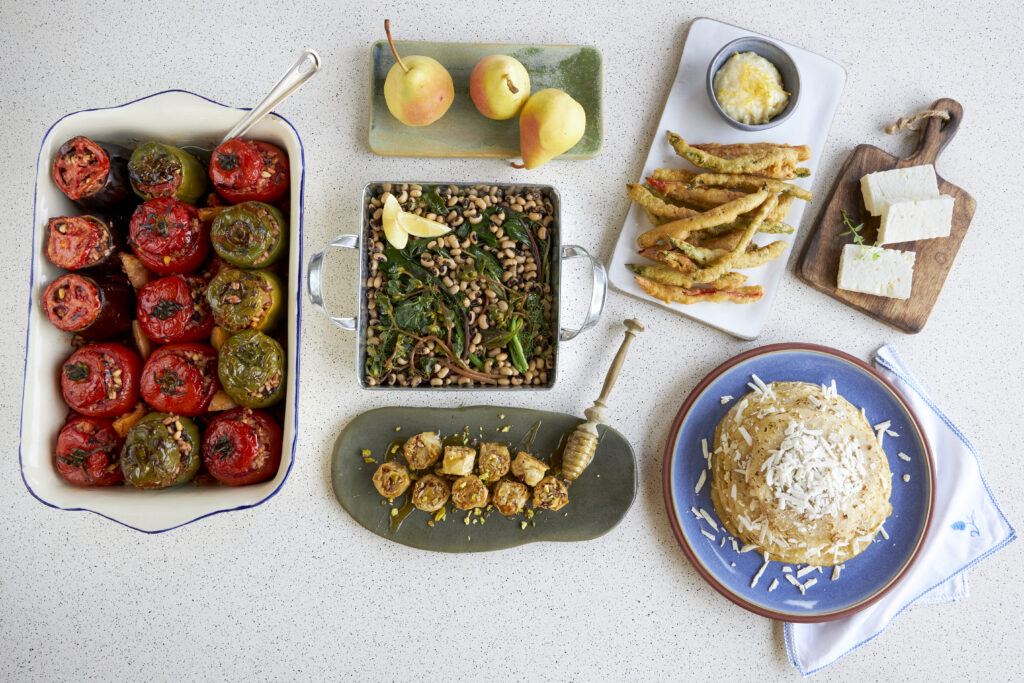
Greek Family Meal 2
Stuffed vegetables, gemista, are the centerpiece of this menu. In this case a mix of farro, pine nuts, raisins, mint, dill and parsley fills peppers, eggplants and tomatoes. Potato chunks wedged between the stuffed vegetables hold them up in the baking dish. A generous drizzle of olive oil and sprinkle of dried oregano are the final touch before baking. A small serving of feta provides dairy protein and complements the dish. This is a more labor-intensive recipe where cooks might make a large batch, so there’s enough to enjoy leftovers later in the week. Mavromatika yahni, a salad or side dish, which is a juicy mélange of black eyed peas, cooked mixed greens, dill and sorel, is a typical dish of the Messinian region. Battered and fried green beans, fassolakia tiganita, served with skordalia could be a mezze or part of a menu like this one. Here ground almonds and mashed potatoes thicken the skordalia, a versatile garlic sauce. But according to Greek culinary expert Aglaia Kremezi the formula varies: “in some parts of Greece skordalia is made with mashed potatoes and some with soaked bread. But if you make it with the bread, it’s not as smooth.” She stirs in a small amount of yogurt just before serving to make it creamier and tame the intensity of the garlic. Whole-wheat flour blends with all-purpose flour in these pétoules, a Messinian take on crepes or flatbreads, cooked in olive oil and sprinkled with a hard Messinian cheese called mizithra. Ripe pears and tiny baklava rolled cookies—just one or two per person—with walnuts, pistachios and almonds finish this meal.

Greek Family Meal 3
Gigantes, giant beans typically baked in a tomato sauce, are a Greek staple. In this version from northern Greece white wine seasoned with garlic, dill and oregano replaces the tomato sauce. Maroulosalata, a salad made with crisp lettuce, arugula, scallion, mint and dill tossed with vinaigrette, appears in winter and spring when tomatoes are not available. Walnuts as a salad topping add healthy plant-based fats and protein. Fassolakia ladera, a dish of green beans braised with olive oil, tomatoes and sometimes other vegetables like carrots or potatoes, is often served with feta cheese. The broth for this soup, kakavia, is made from small bony fish. Zucchini, carrots and a few mussels simmer in the broth. Mussel farming in northern Greece has boomed since the 1980’s, although the industry is struggling with high sea temperatures associated with climate change. Whole grains appear in this menu in the form of a basic loaf of bread as well as a more festive rolled loaf stuffed with olives and herbs, eliopita. Whole walnuts served along with dried figs, finish the meal and bring servings of fruit and nuts to the mix.
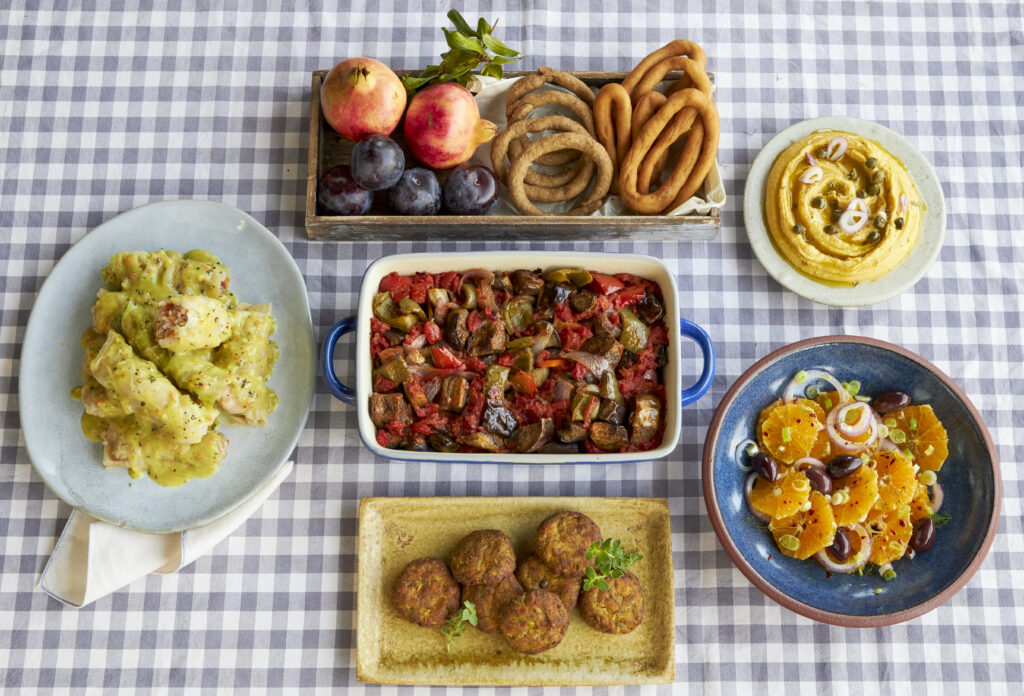
Greek Family Meal 4
The filling for Greek rolled and stuffed cabbage, lahanodolmades, is sometimes heavy on the meat and rice (especially in recent years), but here whole-grain bulgur replaces some of the meat. Shredded zucchini combines with oregano, parsley, almonds and feta cheese in these baked patties, kolokythokeftedes. Greek cooks make this sort of patty, according to Greek culinary expert Aglaia Kremezi, “as a vegetarian version of meatballs. You can make them with anything— greens, spinach, squash, of course, and all kinds of vegetables.” Olive groves blanket the landscape of the Peloponnese, but oranges are another important regional crop. This Messinian salad, Maniatiki salata, also found in the northwest of Greece and in Albania, pairs oranges with olives and onions, and brings a serving of fruit to the table. This baked dish similar to ratatouille, melitzanes sto fourno, combines eggplant, onion, pepper and tomato. What Greeks call fava is a puree of small yellow peas which hails from the island of Santorini. Originally made from an heirloom type of grass pea that grew well on the steep rocky island, today most recipes call for yellow split peas instead. Olive oil, sliced onion, capers, dried oregano and lemon top the fava. Curved, fried bread sticks, lalagia, a specialty of the Messinian region, are seasoned with fennel and sesame. In-season fruits—plums and pomegranates—round out the menu.
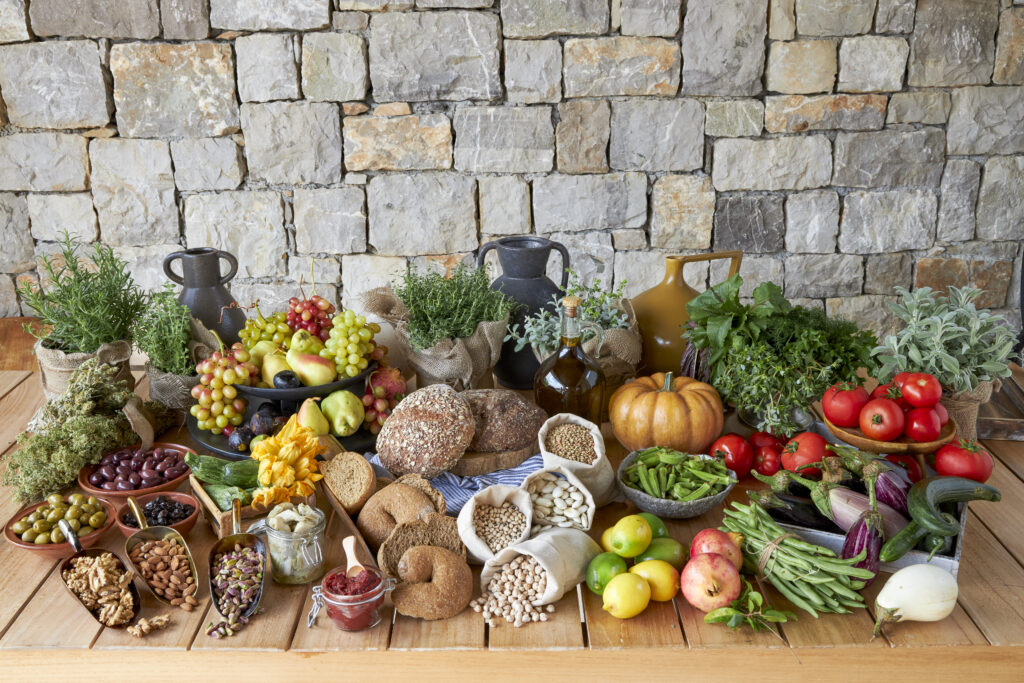
Greek cuisine makes abundant use of vegetables including tomatoes, cucumbers, eggplant, artichokes, green beans, all sorts of greens (both wild and cultivated), zucchini, winter squash and okra. Whatever fresh fruits are in season—from pears and grapes to figs, melons, plums and pomegranates—they make their way to the table, especially as a simple ending to a meal. Lemons, especially used as a tart final seasoning on dishes, are ubiquitous. The 2025 EAT-Lancet Commission’s recommended Planetary Health Diet calls for half of daily calories to come from fruits and vegetables and it suggests eating as wide a variety of each as possible both for health and biodiversity. Tomato paste features heavily in Greek cooking. “It is the Eastern Mediterranean version of umami,” says Greek food expert Aglaia Kremezi. “And the most common way it’s used is after sautéing the onions you add it to the pan and fry it in a bit of oil.”
Beans and pulses, especially garbanzos, black eyed peas, gigantes and lentils are an important source of plant-based protein in the diet, as are nuts like walnuts, almonds and pistachios. Many areas have a tradition of growing and milling grains, even on the steep rocky Cycladic Islands where they are grown on strips of terraced land. These grains are baked into rustic, fresh whole-grain loaves or the small twice-baked barley flour biscuits, dakos. Herbs like oregano, rosemary, sage, marjoram and thyme play an important role in the cuisine. The Taygetos mountains near Kalamata are known for wild oregano, which is sold dried in bunches. And the throughline of traditional Greek cuisine is olive oil, from the fruit of the olive tree—barely a dish is made without it. Historically, 35-40% of the calories in the healthy, traditional Greek Mediterranean diet have come from fats and oils, mostly olive oil.
Greek Olive Harvest in Messinia
The Messinian region in the Peloponnese is one of the most significant olive growing areas in Greece. The olive harvest starts there in October and runs until early winter. Here, workers harvest the olives by hand using the traditional method with small rakes to shake the olives loose. This method protects both the trees and the olives. The harvested olives can be green, purple or black depending on whether the olives are harvested early or late in the season. Early harvest extra-virgin olive oils (EVOO’s) are prized for their increased levels of fruitiness, bitterness and/or pungency as a complement to a wide range of traditional Greek dishes. These early harvest oils are also typically higher in polyphenols and other beneficial minor components that contribute to the positive health impacts of the traditional Greek Mediterranean dietary pattern.
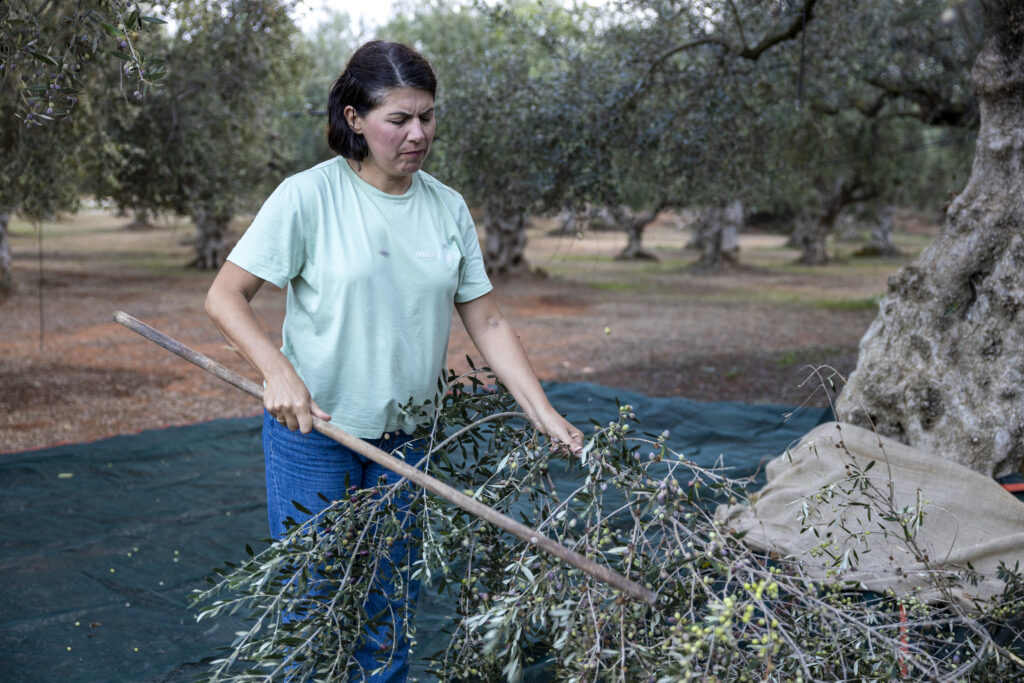
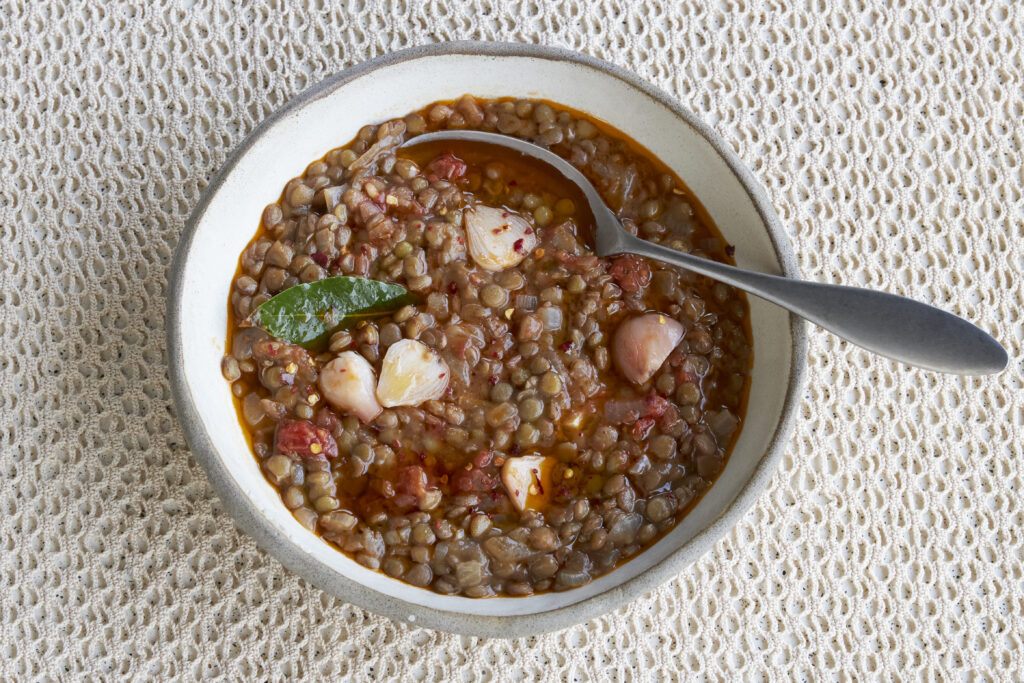
Lentil Soup
Lentil soups, faki, like this one spiced with Aleppo pepper, studded with pickled hyacinth bulbs and drizzled with olive oil, bring legumes (pulses) to the Greek diet. Other classic Greek legume-based soups are made with chickpeas in the case of revithada and white beans for fassolada. A common step for soups like these is the addition, at the end of cooking, of acid in the form of lemon or vinegar. A spoonful of tomato paste added earlier in the cooking can lend both umami, sour and sweet.
Horta
Greek foragers collect wild greens, horta, which sprout from the rugged country landscape especially after rains. A huge variety—cresses, mustard greens, sorrel, wild asparagus, nettles, amaranth, dandelion, purslane and chicory, to name just a few—find their way to the Greek kitchen. Of course, cultivated greens like Swiss chard, beet greens, arugula, escarole and spinach may appear as well in a dish like this. This side of horta is the most basic and common Greek preparation for greens—boiled until tender, seasoned with salt and served at room temperature with lemon and a liberal amount of olive oil.
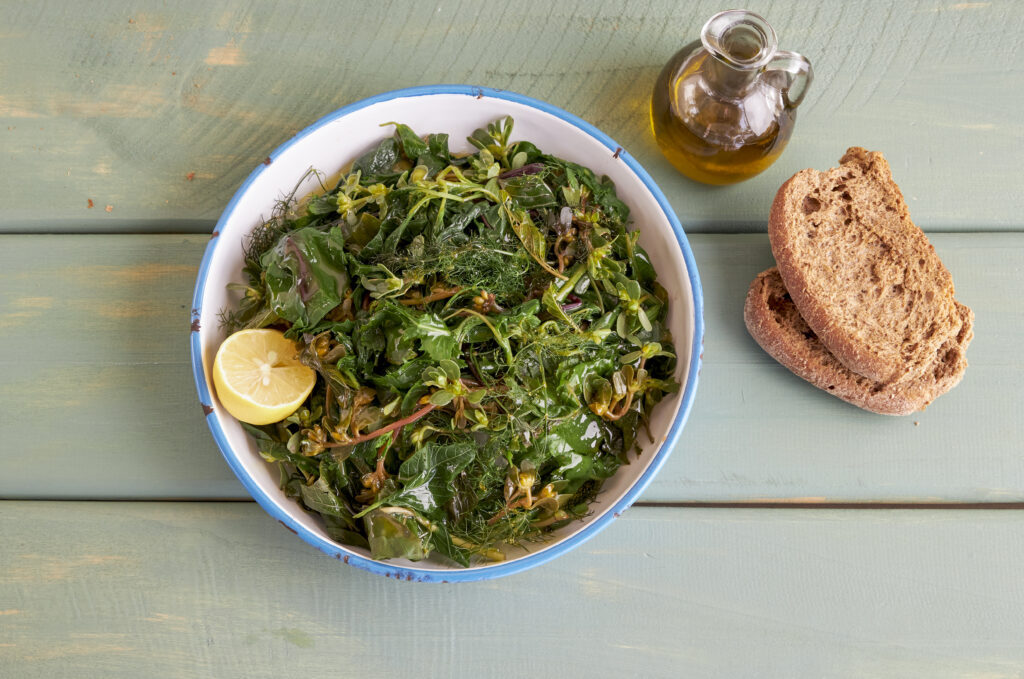
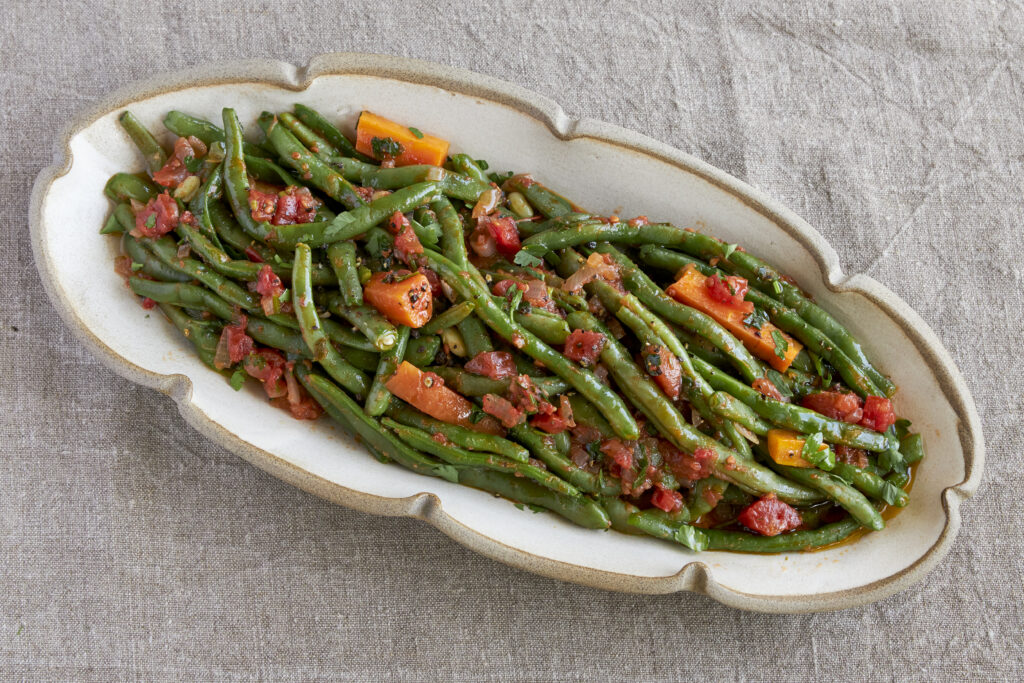
Fasolakia Ladera
Braising in olive oil, ladera is a technique used with greens beans as well as other vegetables like zucchini. Known as fassolakia ladera, this dish features green beans cooked along with onions, garlic, carrots and tomatoes. As Aglaia Kremezi describes in The Foods of the Greek Islands, “On the islands, these religious rules (of regularly abstaining from animal-based foods) are followed by most of the people, and the local tavernas, which usually serve grilled meat or fish, offer ladera, vegetable stews cooked with olive oil during Lent.” As a simple dinner these beans might be served with whole-grain bread, olives and feta.
Grilled Anchovies
Whole tiny fish like these anchovies, gavros are often fried in Greece, but for home cooks this technique—dredged in flour, placed on a baking sheet, brushed with olive oil and baked—is easier and less messy.
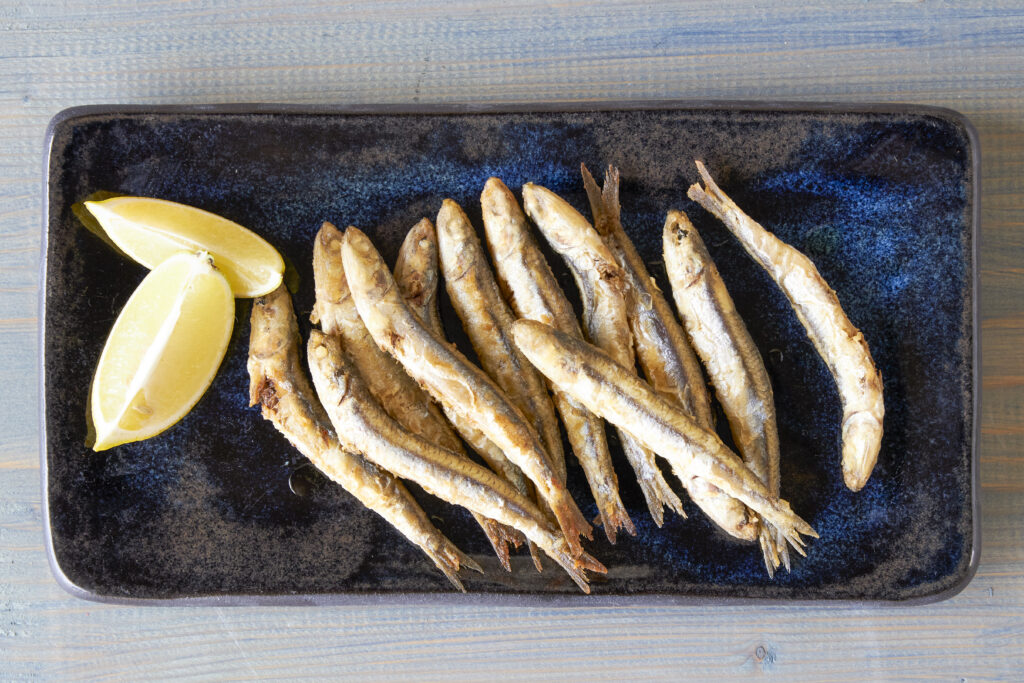

Gigantes
Legumes (pulses) appear yet again in the Greek diet in the go-to dish gigantes, made of large, flat white beans (known as gigantes). Greek cooks first soak and then simmer them for about 40 minutes on the stovetop, a sort of precook. Finally, the beans are transferred to a casserole, along with garlic, onions, oregano, wine and just a little bit of cooking water, covered tightly and then baked slowly. A finish of fruity, somewhat peppery Greek extra-virgin olive oil elevates the flavors of this beloved Greek bean dish.
Black-Eyed Peas and Greens
While black-eyed peas are typical in Greek cuisine, this combination with greens is one that is more common in the Peloponnese. The 2025 EAT-Lancet Commission’s dietary pattern recommends eating 0-150 grams (2 to 3 servings) of beans, lentils, peas and soy a day and 200 to 600 grams (about 3 to 7 servings depending on type) of vegetables a day. A dish like this one, that combines beans and vegetables, helps Greeks reach those targets.
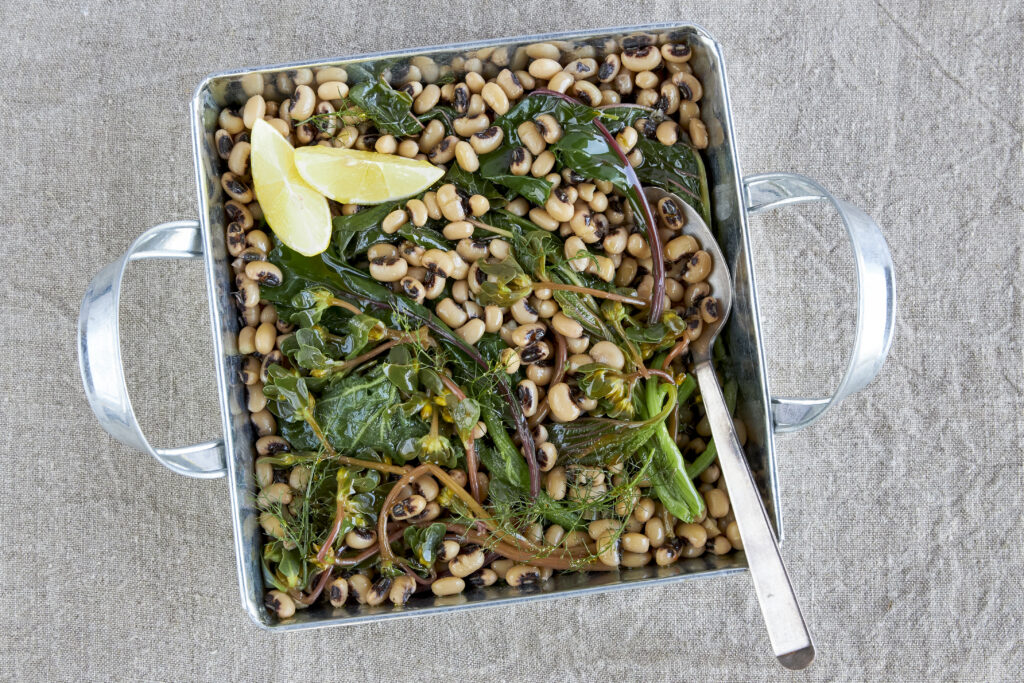
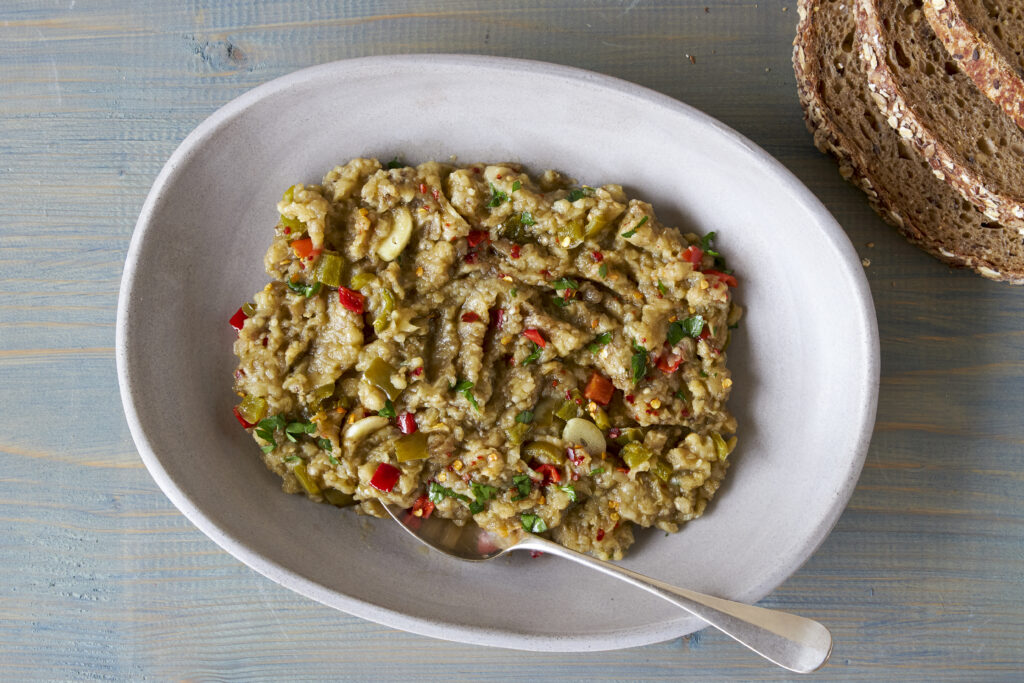
Eggplant Spread
Greeks have a solid repertoire of dishes like this side/mezze made from eggplant, melitzanosalata, that help them load up on vegetables. A favorite vegetable throughout the Mediterranean, here eggplants are broiled or grilled whole until their skins are charred and their flesh is tender. Once cooked, the tender flesh combines with peppers, garlic, almonds, parsley, olive oil and vinegar to form a creamy spread that’s at home with crusty whole-grain bread and a chunk of feta.
Kalamata Public Market: Shopping for Eggplant, Nuts & Legumes, Fish and Herbs
Kalamata, home to the eponymous olive as well as being the center of the region’s olive oil production, is on the Messinian Gulf and is the second largest city in the Peloponnese. The city farmers’ (public) market, open on Wednesdays and Saturdays, features vendors from all over the region. Displays of fruits and vegetables, nuts and legumes, olives and olive oil dominate. Bundles of dried and fresh herbs, many gathered from the nearby mountains, perfume the air. Shoppers come to pick up locally caught fish and seafood.
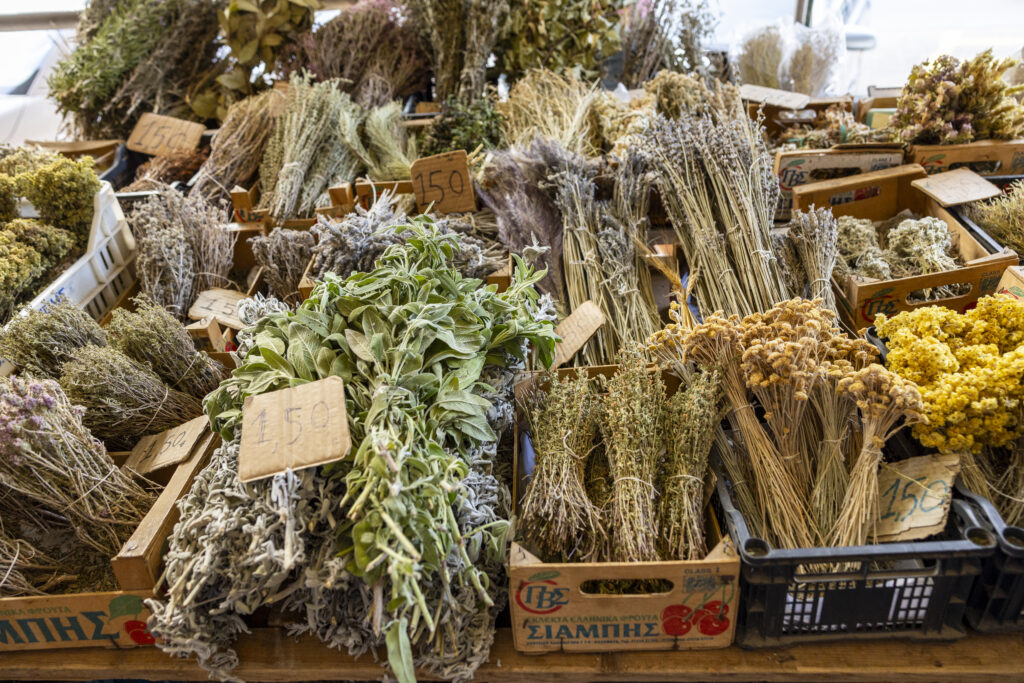
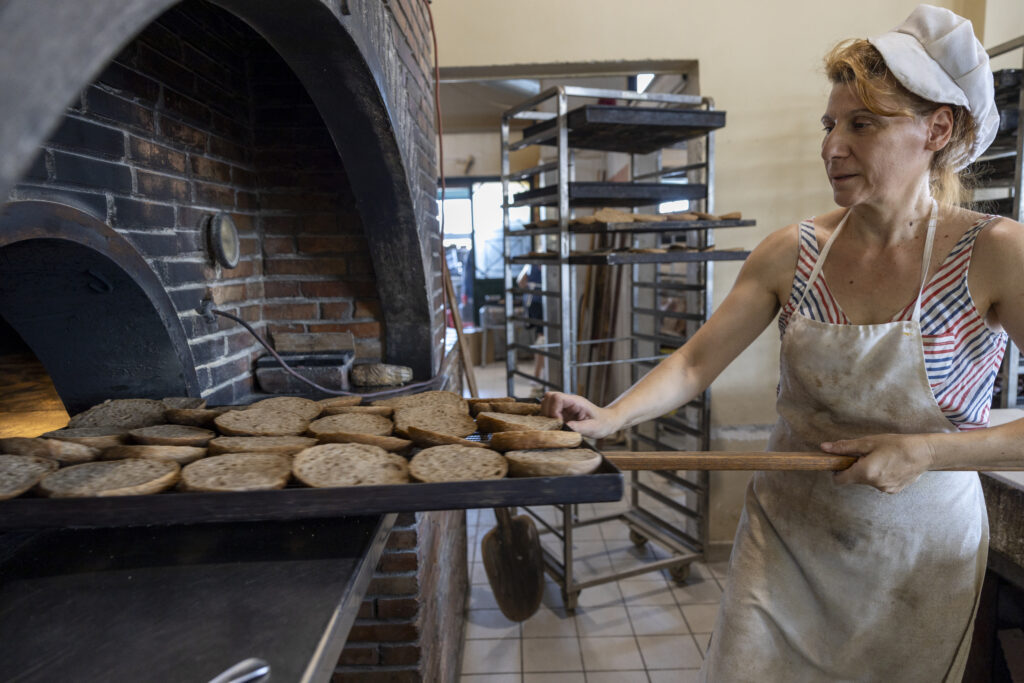
Local Bakery: Dakos
After an initial bake and slicing, the baker returns these biscuits, dakos, to the low heat oven at Nikolopoulos Bakery in Kalamata to dry. Also known as paximadia, these whole-grain barley flour biscuits have been at the core of the Greek diet for millennia. “Barley was the main grain, especially in the mountainous parts of Greece where it’s not easy to grow wheat. And while you can make bread from barley flour,” says Aglaia Kremezi, “you cannot really keep it for a few days. You must eat it the first day. So, they began cutting it and drying it slowly in the oven.” Bakers throughout the Aegean islands make dakos, but those from Crete are the most famous. They might be crumbled in soups, soaked in water and mixed with spices, or topped with chopped or grated tomatoes, capers, olives, feta and olive oil.
Local Bakery: Oven-Roasted, Stuffed Vegetables
Locals bring dishes prepared at home like these stuffed vegetables, gemista, to bake in the wood burning oven at Nikolopoulos Bakery in Kalamata. Once common practice, bringing a dish to bake in the town oven is a tradition that is disappearing throughout Greece as home kitchens modernize. Dishes baked in a communal oven like this one take on a delicious, smoky dimension that can’t be replicated in a home oven. But oven-roasted, stuffed vegetables continue to be a favorite on Greek tables—however they are baked.
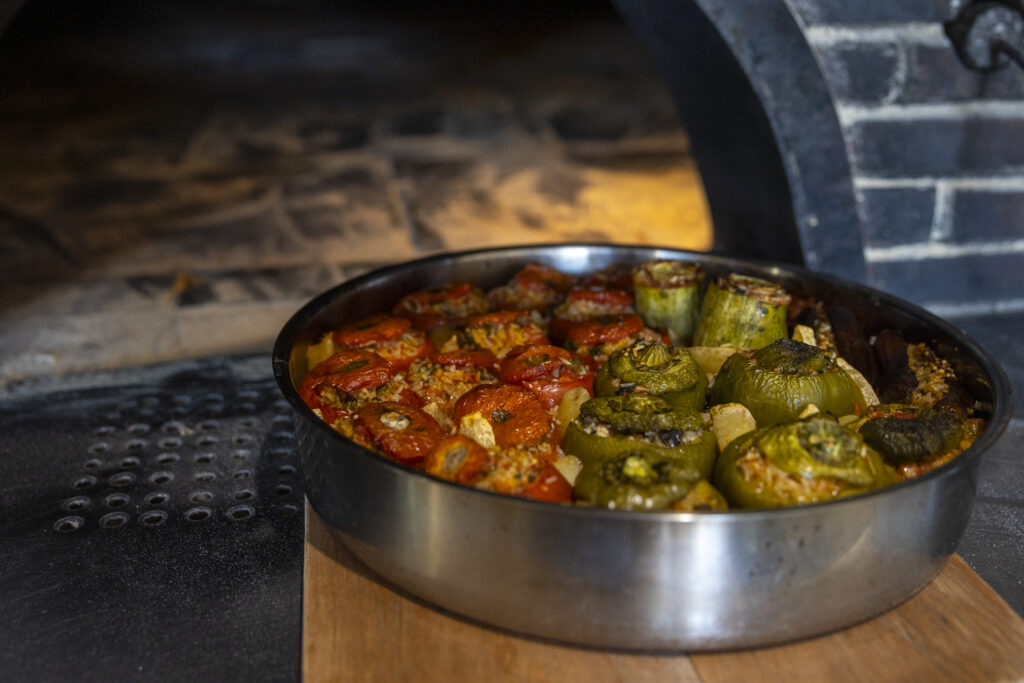
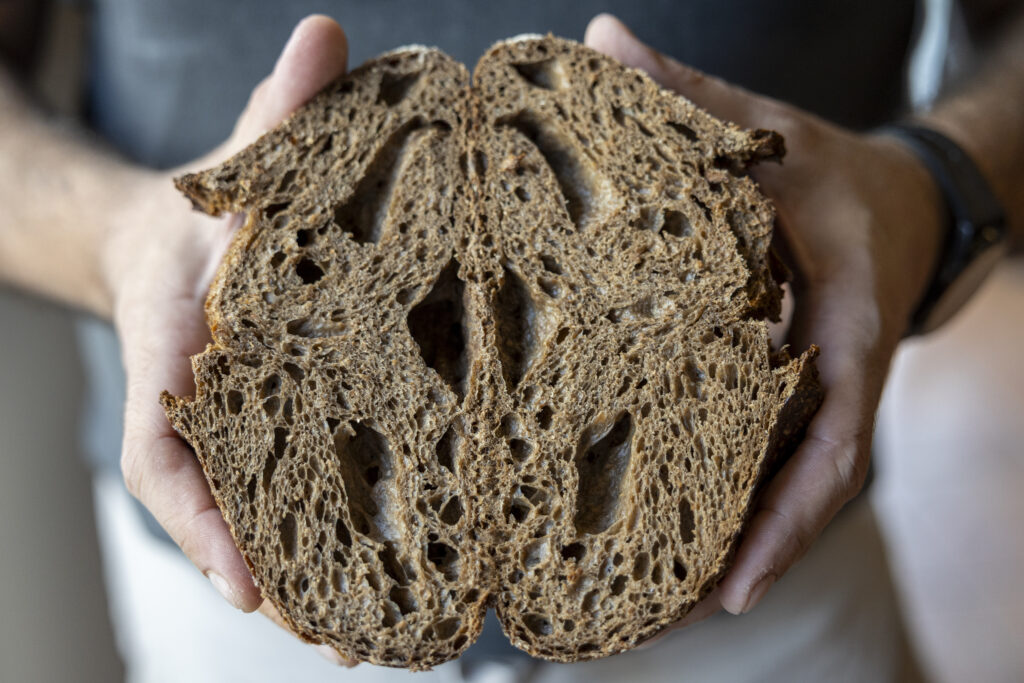
Local Bakery: Long-Fermentation Whole Grain Breads
Step into Seirios Bakery in Messini, a small-town west of Kalamata in the Peloponnese, and you’ll find that whole-grain loaves using barley, whole-wheat and rye grains feature heavily. These breads, with shapes inspired by French bread making traditions, weave in the Greek influence with their reliance on whole grains. Longer, slower fermentation of whole grain breads, as practiced at Seirios Bakery, makes for a final product with enhanced flavor and texture and greater customer appeal.
Making Hortopita
Hortopita pie is the cousin of spanakopita, the former made with horta, a blend of edible wild greens, and the latter made with spinach. Fresh dill, feta, onions and scallions season the greens for the filling. Traditionally both pies are made with a thin homemade phyllo crust of flour and olive oil, rolled out by hand as this woman does. The Messinian version of phyllo has lots of olive oil (and uses exclusively olive oil) and the resulting crust is more similar to a pie dough made with flour and butter or lard than it is to what you might get using layers of phyllo dough. These kinds of typically hand-held stuffed pies are a favorite with Greeks and yet another way that vegetables and olive oil are able to claim the center of the traditional, healthy Greek diet.
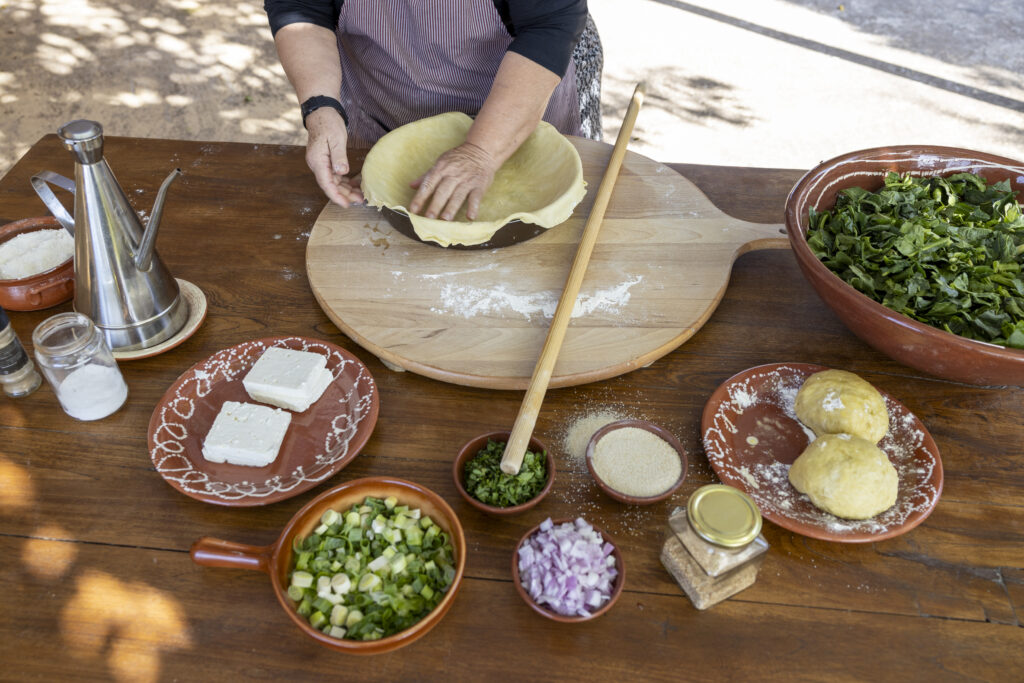
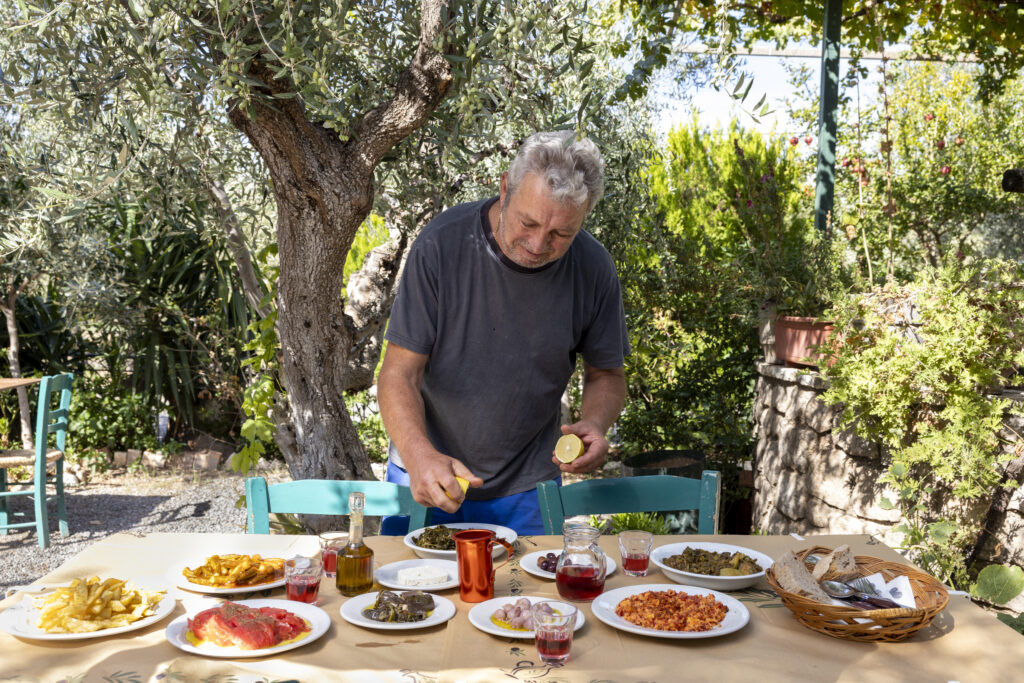
Local Kalamata Taverna
At Vagias Taverna in Kalamata, third-generation owner Giannis Vagias welcomes guests and offers a wide array of plant-rich dishes (from top left, clockwise): okra braised with tomatoes, bamies; boiled horta; olives; stems of zucchini plants, peeled and diced then braised in olive oil, with tomato paste, kolokythokorfades yahni; whole grain bread; strapatsada, scrambled eggs with tomatoes; pickled wild hyacinth bulbs known as volvi; melitzanaki toursi, pickled eggplant stuffed with garlic, celery and hot peppers; domatosalata, peeled and halved tomatoes from the garden with olive oil and oregano; patates tiganites, potatoes fried in olive oil.
Fish and Shellfish on the Greek Table
Although Greece is surrounded by water, Greek annual per capita consumption of seafood averages around a relatively modest 22 kilos. Much of the fish eaten in Greece is now imported, however aquaculture has seen huge growth since 1960 and commercial fishing in local waters continues. Today in Kalamata commercial fishermen like Giannis Maounos use 32-millimeter mesh nets to catch the medium and small species in the Messinian Gulf such as leerfish, greater amberjack, mullet and John Dory. Fish and other aquatic foods are an important part of the traditional Mediterranean Diet and the Planetary Health Diet and are a favorite of Greek people.
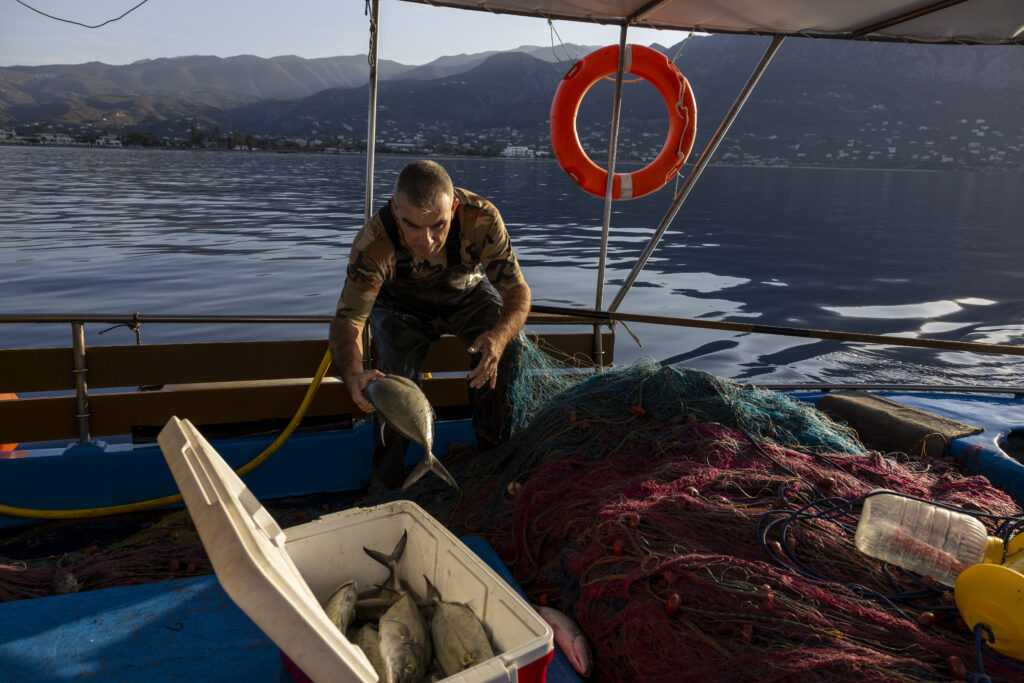
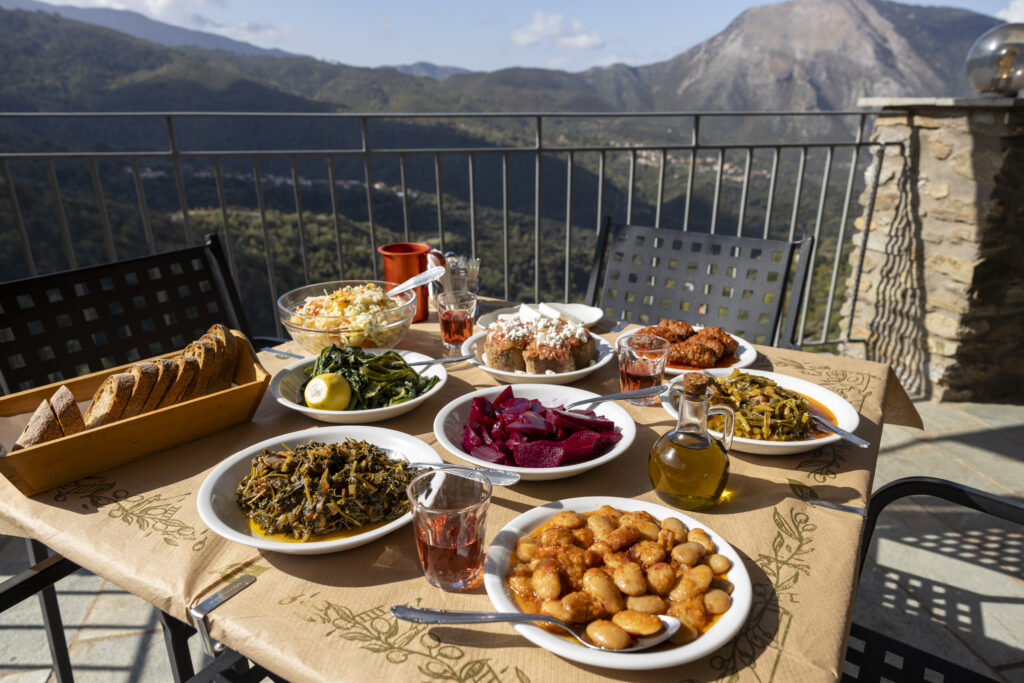
Local Taverna in the Mountains
The Mavrikis family has operated Mavrikis Taverna on the slopes of the Taygetos mountains northeast of Kalamata since 1879. The restaurant perches on a rugged hillside with a sweeping view of the surrounding mountains. Ingredients from the region appear in dishes like these (clockwise, from lower right): slow cooked giant beans, gigantes; braised greens with a small amount of lamb or beef shank, kreas me horta; beets, patzaria; boiled wild greens, horta; cabbage salad dressed with lemon and olive oil, lahanosalata; dakos topped with tomatoes and feta; meatballs cooked in a flavorful tomato sauce usually with cumin, soutzoukakia; and braised zucchini stems, kolokythokorfades yahni. Whole-grain bread, feta, olive oil and red wine round out the menu.
Project producer and editorial director: Jessie Price, consulting editor and former editor-in-chief, Eating Well magazine
Culinary director: Aglaia Kremezi, Greek food expert and author, The Foods of Greece, The Foods of the Greek Islands and Mediterranean Vegetarian Feasts; owner, Kea Artisanal cooking school
Photography: Penny De Los Santos, visual storyteller who has documented food and culture globally for 20 years.
Photographed on location in Kalamata, Pylos and other locations in the region of Messinia, Greece
Made possible by a grant from EAT and The Rockefeller Foundation
Special thanks to Captain Vassilis & Carmen Constantakopoulos Foundation and Costa Navarino for their additional support and to the talented cooks, chefs and other food professionals in the region of Messinia for their time and project participation.
© 2025 The Culinary Institute of America. All rights reserved.

